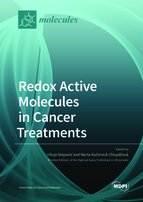Redox Active Molecules in Cancer Treatments
A special issue of Molecules (ISSN 1420-3049). This special issue belongs to the section "Medicinal Chemistry".
Deadline for manuscript submissions: closed (31 October 2021) | Viewed by 54327
Special Issue Editors
Interests: redox active compounds; anticancer treatment; chemoprevention; natural products and derivatives
Special Issue Information
Dear Colleagues,
The primary purpose of this Special Issue of Molecules is to present the results of in vitro, in vivo, and/or in silico studies of the biological effects and activities of the redox-active compounds observed in original research studies or collected and discussed in review articles.
It is already accepted that the change of cells' redox status changes their biological setup [[i]]. Accumulation of reactive oxygen species (ROS) leads to oxidative stress and, consequently, activation of redox-sensitive transcription factors, signalling and metabolic pathways, and orchestrated cell death. Antioxidants like some polyphenols, vitamin C, beta carotenes and glutathione have mostly been investigated because of their chemopreventive capabilities and direct and indirect ROS scavenging effects [[ii],[iii],[iv]]. However, recently the interest in pro-oxidant compounds has increased in association with the promotion of regulated death of cancer cells or with the development of novel anticancer approaches based on the selective inhibition of sustained NRF2/KEAP1 pathway in the cancer cells [[v],[vi]].
We would like to you invite to publish in this Special Issue data from original research studies or reviews focusing on chemical and pharmacological aspects of natural and (semi)synthetic molecules that change cellular ROS concentration and can exert antioxidant and/or pro-oxidant cellular effects. Topics include but are not limited to:
- synthesis and modification of small molecular weight redox modulators with potential pharmacological applications, and the optimization of their antioxidant /pro-oxidant properties and ADMET profile
- non-radical targeted scavenging mechanisms of action of redox modulators such as modulators of activities or/and transcription of glutathione peroxidases, catalase, glutathione-S-transferases and superoxide dismutases as well as KEAP1-NRF2 pathway
- antioxidants with chemopreventive effects
- compounds capable of modifying ROS levels and potentiating the effect of anticancer drugs
- molecular sensitizers used in cancer therapy
- redox-active compound affecting regulated cell deaths
[i]. Buettner, G.R.; Wagner, B.A.; Rodgers V.G. Quantitative redox biology: An approach to understand the role of reactive species in defining the cellular redox environment. Cell Biochem. Biophys. 2013, 67(2), 477-483. doi:10.1007/s12013-011-9320-3
[ii]. Stepanić V, Čipak Gašparović A, Gall Trošelj K, Amić D, Žarković N. Selected attributes of polyphenols in targeting oxidative stress in cancer. Curr. Top. Med. Chem. 2015, 15(5), 496-509. doi:10.2174/1568026615666150209123100
[iii]. Harej A, Macan Meščić A, Stepanić V, Klobučar M, Pavelić K, Pavelić Kraljević S, Raić-Malić S. The Antioxidant and Antiproliferative Activities of 1,2,3-Triazolyl-L-Ascorbic Acid Derivatives. Int. J. Mol. Sci. 2019, 20(19), 4735. doi:10.3390/ijms20194735
[iv]. Stepanić, V.; Matijašić, M.; Horvat, T.; Verbanac, D.; Kučerová-Chlupáčová, M.; Saso, L.; Žarković, N. Antioxidant Activities of Alkyl Substituted Pyrazine Derivatives of Chalcones—In Vitro and In Silico Study. Antioxidants 2019, 8, 90. doi:10.3390/antiox8040090
[v]. Perillo, B.; Di Donato, M.; Pezone, A.; Di Zazzo, E.; Giovannelli, P.; Galasso, G.; Castoria, G.; Migliaccio, A. ROS in cancer therapy: the bright side of the moon. Exp. Mol. Med. 2020, 52(2), 192-203. doi:10.1038/s12276-020-0384-2.
[vi]. Panieri, E.; Buha, A.; Telkoparan-Akillilar, P.; Cevik, D.; Kouretas, D.; Veskoukis, A.; Skaperda, Z.; Tsatsakis, A.; Wallace, D.; Suzen, S.; Saso, L. Potential Applications of NRF2 Modulators in Cancer Therapy. Antioxidants 2020, 9(3), 193; doi:10.3390/antiox9030193
Dr. Višnja Stepanić
Dr. Marta Kučerová-Chlupáčová
Guest Editors
Manuscript Submission Information
Manuscripts should be submitted online at www.mdpi.com by registering and logging in to this website. Once you are registered, click here to go to the submission form. Manuscripts can be submitted until the deadline. All submissions that pass pre-check are peer-reviewed. Accepted papers will be published continuously in the journal (as soon as accepted) and will be listed together on the special issue website. Research articles, review articles as well as short communications are invited. For planned papers, a title and short abstract (about 100 words) can be sent to the Editorial Office for announcement on this website.
Submitted manuscripts should not have been published previously, nor be under consideration for publication elsewhere (except conference proceedings papers). All manuscripts are thoroughly refereed through a single-blind peer-review process. A guide for authors and other relevant information for submission of manuscripts is available on the Instructions for Authors page. Molecules is an international peer-reviewed open access semimonthly journal published by MDPI.
Please visit the Instructions for Authors page before submitting a manuscript. The Article Processing Charge (APC) for publication in this open access journal is 2700 CHF (Swiss Francs). Submitted papers should be well formatted and use good English. Authors may use MDPI's English editing service prior to publication or during author revisions.
Keywords
- Antioxidants
- Pro-oxidants
- Gene transcription modulation
- Signalling pathways modulation
- Metabolic pathways modulation
- Cancer therapy







